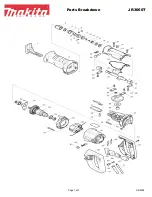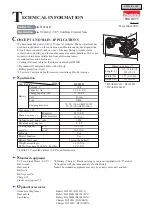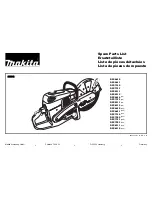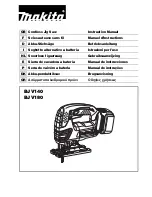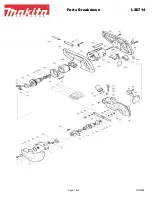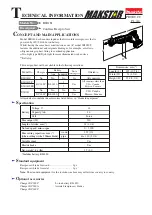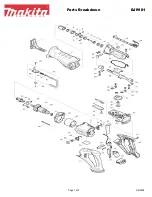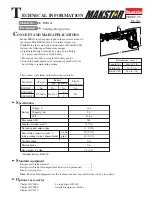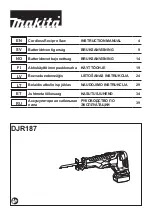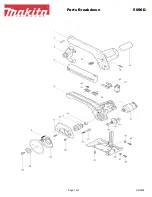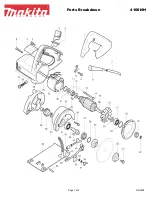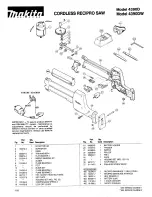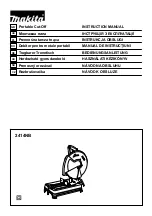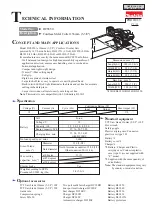
4
5
Grounded Tools:
Tools with Three Prong Plugs
Tools marked “Grounding Required” have a three
wire cord and three prong grounding plug. The
plug must be connected to a properly grounded
outlet (See Figure A). If the tool should electrically
malfunction or break down, grounding provides a
low resistance path to carry electricity away from
the user, reducing the risk of electric shock.
The grounding prong in the plug is connected
through the green wire inside the cord to the
grounding system in the tool. The green wire in the
cord must be the only wire connected to the tool's
grounding system and must never be attached to
an electrically “live” terminal.
Your tool must be plugged into an appropriate out-
let, properly installed and grounded in accordance
with all codes and ordinances.
The plug and outlet should
look like those in Figure A.
Double Insulated Tools:
Tools with Two Prong Plugs
Tools marked “Double Insulated” do not require
grounding. They have a special double insula-
tion system which satisfi es OSHA requirements
and complies with the applicable standards of
Underwriters Laboratories,
Inc., the Canadian Stan-
dard Association and the
National Electrical Code.
Double Insulated tools may
be used in either of the
120 volt outlets shown in
Figures B and C.
Fig. B
Fig. C
Fig. A
GROUNDING
WARNING
Improperly connecting the
grounding wire can result in the risk of elec-
tric shock. Check with a qualifi ed electrician
if you are in doubt as to whether the outlet is
properly grounded. Do not modify the plug
provided with the tool. Never remove the
grounding prong from the plug. Do not use
the tool if the cord or plug is damaged. If
damaged, have it repaired by a MILWAUKEE
service facility before use. If the plug will not
fi t the outlet, have a proper outlet installed by
a qualifi ed electrician.
Grounded tools require a three wire extension
cord. Double insulated tools can use either a two
or three wire extension cord. As the distance from
the supply outlet increases, you must use a heavier
gauge extension cord. Using extension cords with
inadequately sized wire causes a serious drop in
voltage, resulting in loss of power and possible tool
damage. Refer to the table shown to determine the
required minimum wire size.
The smaller the gauge number of the wire, the
greater the capacity of the cord. For example, a 14
gauge cord can carry a higher current than a 16
gauge cord. When using more than one extension
cord to make up the total length, be sure each cord
contains at least the minimum wire size required. If
you are using one extension cord for more than one
tool, add the nameplate amperes and use the sum
to determine the required minimum wire size.
Guidelines for Using Extension Cords
• If you are using an extension cord outdoors,
be sure it is marked with the suffi x “W-A” (“W”
in Canada) to indicate that it is acceptable for
outdoor use.
• Be sure your extension cord is properly wired
and in good electrical condition. Always replace
a damaged extension cord or have it repaired by
a qualifi ed person before using it.
• Protect your extension cords from sharp objects,
excessive heat and damp or wet areas.
READ AND SAVE ALL
INSTRUCTIONS FOR
FUTURE USE.
Recommended Minimum Wire Gauge
for Extension Cords*
Extension Cord Length
* Based on limiting the line voltage drop to
fi ve volts at 150% of the rated amperes.
Nameplate
Amperes
0 - 2.0
2.1 - 3.4
3.5 - 5.0
5.1 - 7.0
7.1 - 12.0
12.1 - 16.0
16.1 - 20.0
25'
18
18
18
18
16
14
12
75'
18
18
16
14
12
10
100'
18
16
14
12
10
150'
16
14
12
12
50'
18
18
18
16
14
12
10
EXTENSION CORDS
ASSEMBLY
WARNING
To reduce the risk of injury,
always unplug tool before attaching or remov-
ing accessories or making adjustments. Use
only specifi cally recommended accessories.
Others may be hazardous.
Double Insulated
No Load Strokes
per Minute (SPM)
Volts Alternating Current
Underwriters Laboratories, Inc.,
United States and Canada
Amps
Symbology
Blade
Collar
Fig. 1
Selecting a Blade
Use
MILWAUKEE
Sawzall
®
Blades for best perfor-
mance. When selecting a blade, choose the right
type and length.
Many types of blades are available for a vari-
ety of applications: cutting metal, wood, nail-
embedded wood, scroll cutting, roughing-in, and
contours.
Many lengths are also available. Choose a length
long enough to extend beyond the shoe and your
work throughout the stroke. For best performance
and longest life, see "Accessories" to select the
best blade for the job.
Installing and Removing Blades
Quik-Lok
®
Blade Clamp
1. Unplug the tool.
2. Be sure the spindle and blade clamp areas are
clean. Metal chips and sawdust may prevent the
Quik-Lok
®
Blade Clamp from clamping securely
(see "Maintenance").
3. To
install
a blade, twist the collar in the direction
of the arrow while inserting the blade into the
clamp until the tang butts against the collar.
Depending on the job, the blade may be inserted
with the teeth facing upward or downward.
4. Release the collar and the spring loaded mecha-
nism will clamp the blade fi rmly in place.
5. Twist the collar in the opposite direction of the
arrow to ensure that the blade is locked into the
clamp.
6. Tug on blade to make sure it is securely locked
in place.
7. To
remove
a blade, twist the collar in the direc-
tion of the arrow while pulling on the blade. Be
careful when handling hot blades.
Removing Broken Blades from the Quik-Lok
®
Blade Clamp
1. Unplug the tool.
2. Broken blades can be removed by the following
methods.
• Point the tool downward, twist the collar, and
shake the tool up and down (
DO NOT
turn on
the tool while your fi ngers are holding the blade
clamp open). The shank of the broken blade
should drop out of the clamp.
• If shaking the tool doesn't work...
In most cases, a corner of the broken blade will
extend beyond the blade clamp. Twist the collar
and pull the broken blade out of the clamp by
this corner.
• If the broken stub doesn't extend far enough to
be grabbed by its corner, use a thin blade with
small teeth (such as a metal cutting blade) to
hook the blade that is jammed in the clamp while
twisting the collar and pull it out.
*Always follow manufacturer instructions*
*AAA Rent-All 225-291-1356*
















